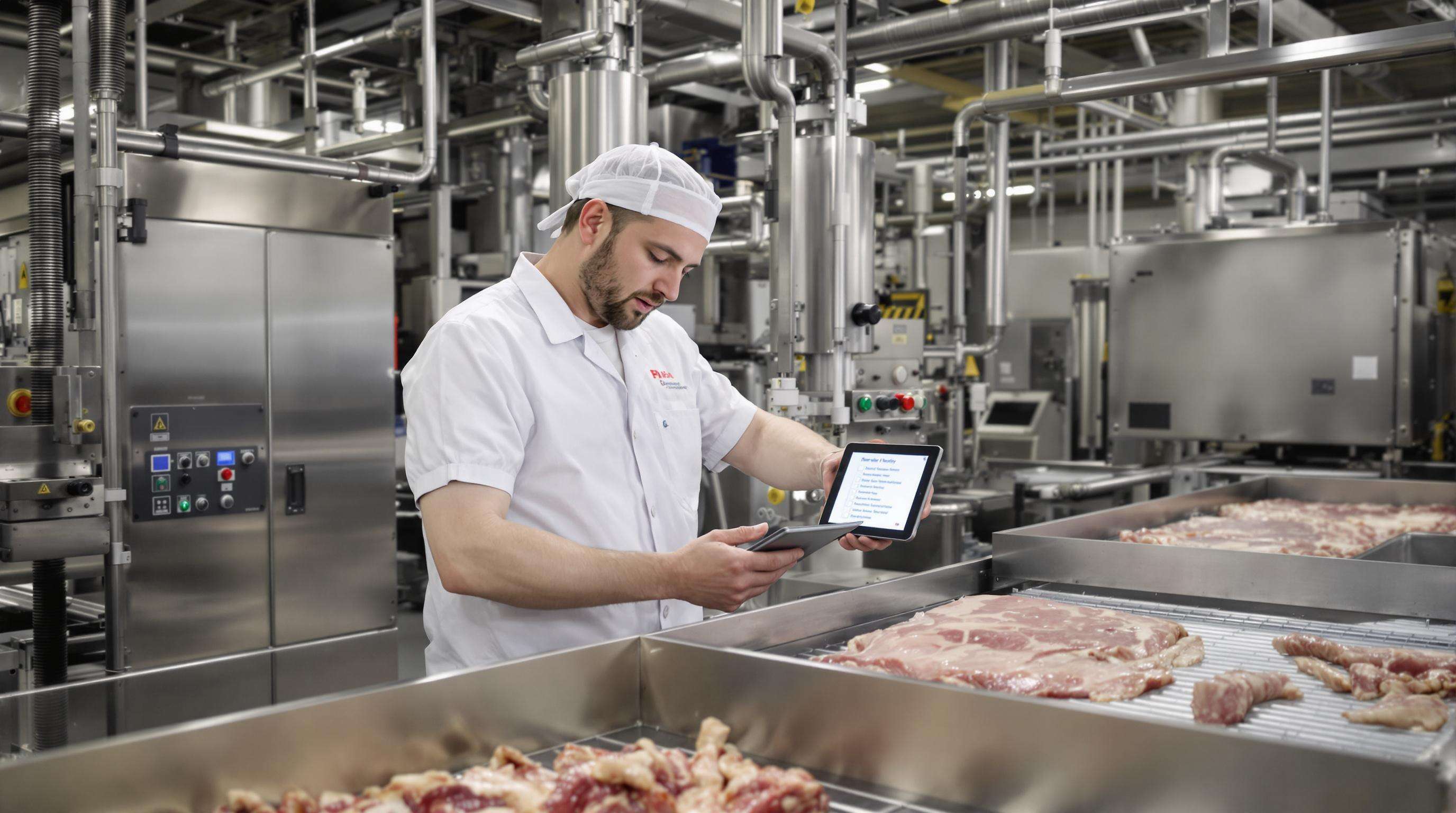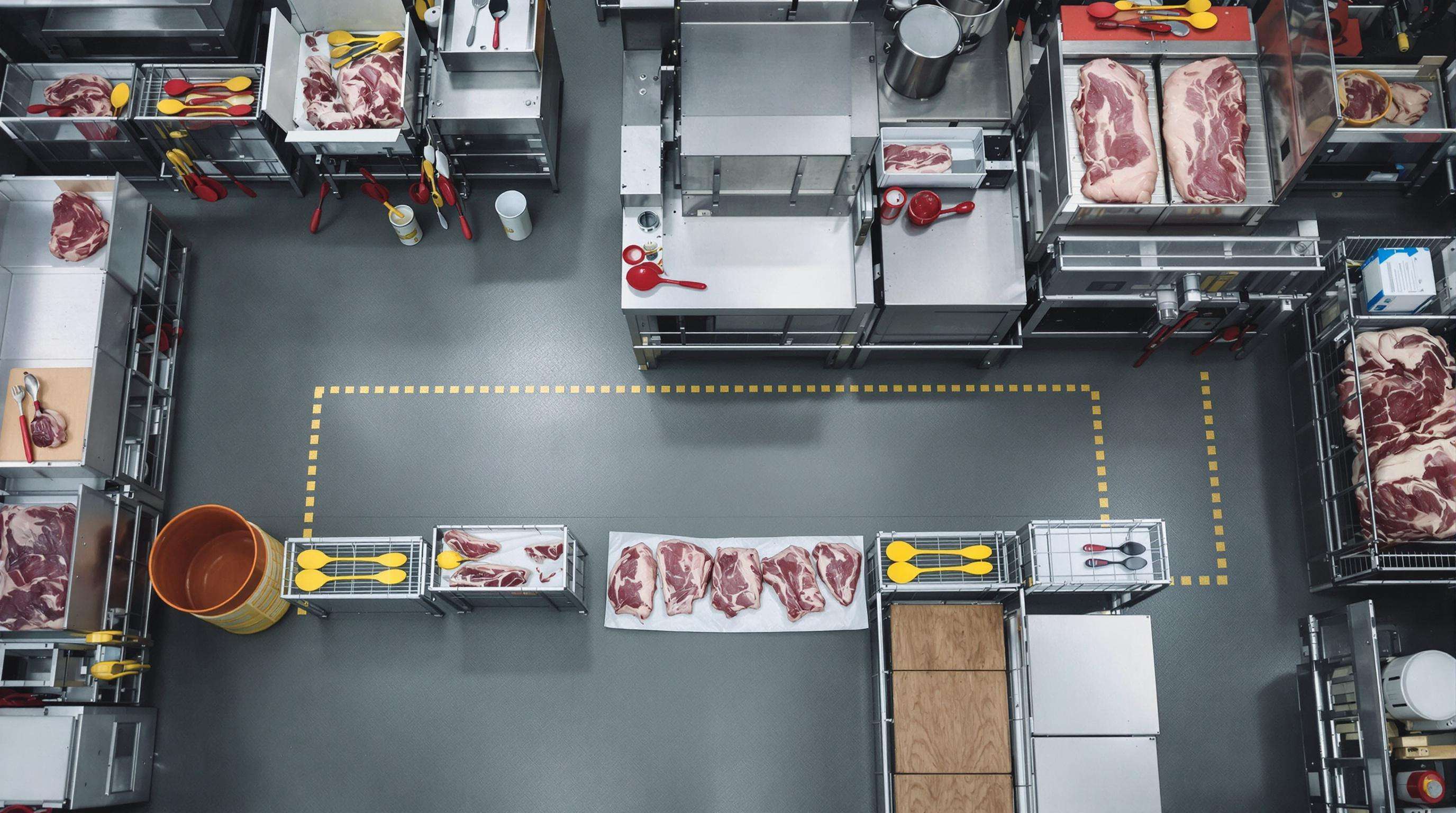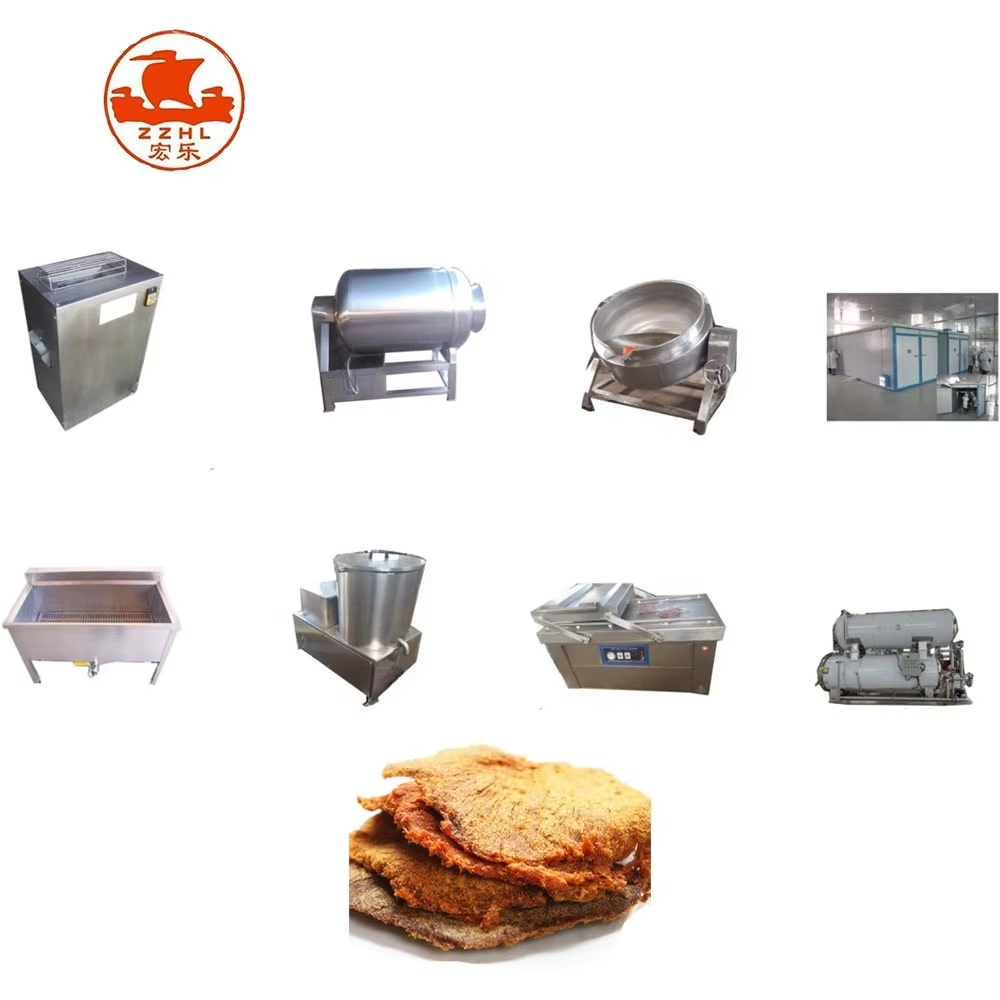Daily Cleaning Protocols for Meat Processing Machines
Step-by-Step Cleaning Procedures After Each Use
Turn off and unplug equipment first for safety’s sake. Scrub removed debris with drinkable water (35-45°C) and food-grade brushes. Scrub all food-contact surfaces with NSF-approved foaming detergents into crevices with the occurrence of bacterial biofilm. Wash it down with gentle hose pressure water (0.3-0.5MPa) to avoid polluting the air. A 2023 study in food safety showed 98% reduction in microbial counts with high-pressure rinses compared to facilities utilizing this protocol.
Lubrication Techniques for Continuous Operation
Use USDA Category H1 lubricants on gears and bearings after cleaning cycles. Apply via drip methods or automatic dispensing systems to avoid overlubrication—excess grease attracts particulate matter, increasing wear rates by 15% (FSIS 2023). Prioritize stainless steel chains and hydraulic pistons, lubricating every 8 operational hours in high-volume facilities.
Verification Methods for Hygiene Compliance
Implement adenosine triphosphate (ATP) bioluminescence testing on 10% of cleaned surfaces daily, with < 200 relative light units (RLUs) as the pass threshold. Document results digitally using timestamped checklists, enabling trend analysis through food safety software. Third-party auditors recommend weekly microbiological swabs focusing on conveyors and dicer blades.
Common Daily Maintenance Oversights to Avoid
- Incomplete removal of fat deposits from under blade guards: Accumulated residues harden within 6 hours, requiring 3× more labor to remove.
- Using non-chlorinated sanitizers on rubber seals: Permeable materials retain 23% more pathogens when treated with peroxide-based formulas (Journal of Food Protection 2024).
- Skipping air-drying steps before reassembly: Moist environments under belts enable Listeria monocytogenes growth rates of 1 log CFU/hr.
Preventive Maintenance Strategies for Meat Processing Equipment

Proactive maintenance extends equipment lifespan by 30-50% compared to reactive fixes according to processing industry studies. By implementing structured preventive approaches, meat facilities minimize contamination risks and unplanned downtime. Four core strategies form this foundation: scheduled inspections, wear-part management, diagnostics, and documentation.
Scheduled Component Inspections
Weekly verification of high-impact elements prevents catastrophic failures. Prioritize these areas:
- Blade integrity and alignment in slicers/bandsaws
- Belt tension and drive train components
- Electrical connections and control panel functionality
- Hydraulic/pneumatic system pressure gauges
Document findings using standardized checklists to track degradation trends. For knives and grinding plates, inspections help maintain optimal micron-level precision during portioning.
Wear-Part Replacement Timelines
Establish replacement schedules based on operational hours, not calendar time. Key benchmarks:
| Component | Replacement Threshold | Failure Consequence |
|---|---|---|
| Conveyor Belts | 2,000 operational hours | Cross-contamination risks |
| Mixer Seals | 1,500 hours | Bacterial ingress points |
| Slicer Bearings | 3,000 hours | Blade wobble inaccuracy |
Track usage through digital counters rather than estimates to maximize part lifespan without compromising hygiene.
Vibration and Noise Diagnostics
Anomalies in equipment acoustics provide early failure warnings. Use handheld vibration meters monthly to:
- Detect bearing wear before seizure occurs
- Identify imbalances in vacuum pump motors
- Pinpoint loose components causing harmonic distortions
Baseline readings taken during commissioning enable deviation analysis. High-frequency sounds often indicate lubrication failures, while low-frequency rumbling suggests structural stress points.
Maintenance Log Implementation
Consistent activity logging transforms reactive repairs into data-driven prevention. Digital logs should capture:
- Maintenance dates and technician IDs
- Parts replaced with batch/lot numbers
- Sanitization completion timestamps
- Energy consumption fluctuations
This creates auditable compliance trails while revealing patterns. Plants analyzing 6+ months of logged data typically reduce repeat breakdowns by 65%. For audit preparedness, automate reminders for calibrations and filter changes through dedicated maintenance software platforms.
Deep Sanitization of Meat Processing Machinery
Chemical Selection for Biofilm Elimination
Sanitizers must be able to penetrate the protective microbial layers and have direct food-grading safety. in 2023 against Listeria biofilms for the QACs, with peroxide sanitizers effective against porous equipment surfaces. Be sure to check cleaner-material compatibility — acidic solutions can corrode aluminum parts, and enzymatic solutions can eat off rubber’s o-rings. Rotate OUT oxidizing (peracetic acid) and non-oxidizing (biguanides) quarterly for heavy buildup to avoid adapted resistance.
Disassembly and Reassembly Best Practices
Full sanitization demands systematic breakdown:
- Prioritize components with direct meat contact (blades, augers)
- Soak parts in <80°F sanitizer to prevent protein coagulation
- Use color-coded brushes to avoid cross-tool contamination
Reassembly errors cause 23% of post-cleaning equipment failures (Food Processing Journal 2022). Follow manufacturer torque specifications for bolts and alignment markers for rotating assemblies. Lubricate bearing surfaces only after complete drying to prevent chemical interactions.
Thermal vs. Chemical Sanitization Comparison
| Factor | Thermal Sanitization | Chemical Sanitization |
|---|---|---|
| Effectiveness | Destroys 99.999% pathogens | Neutralizes 99.9% microbes |
| Application Time | 30+ minutes at 180°F | 5-10 minutes contact time |
| Equipment Impact | Warps plastic components | Corrodes unprotected metals |
| Operational Cost | $14/hr (energy) | $8/hr (chemicals) |
Thermal methods suit stainless steel systems with integrated heating, while chemical fogging reaches complex geometries in grinders and stuffers.
Pathogen Testing Post-Sanitization
Validating sanitization success requires triple-method verification:
- ATP bioluminescence for immediate organic residue detection (<10 RLU threshold)
- Surface swab cultures incubated for 48hrs to confirm bacterial elimination
- Allergen-specific lateral flow tests for protein residue clearance
Facilities combining these methods achieve 97% compliance in FDA inspections (2024 Food Safety Benchmark Report). Always test high-risk zones first: blade teeth, auger threads, and fluid discharge ports.
Machine-Specific Maintenance Guides
Meat Saws: Blade Care and Alignment
Blade tensioning is one of the most important aspects of the meat saw. Practice guidelines suggest 20–25 kN/ sq.)It would be recommended that a long-term monitoring of the tissue is performed, with an elastometry system able to provide such values with good accuracy. mm stress levels. Misalignment beyond 0.1mm quickly leads to apparent bone dust and motor strain — a 2023 USDA report estimated 18% of saw stoppages were due to tracking issues. For cleaning, avoid the abrasives and opt for a good food-grade detergent (the abrasives can develop tiny nicks where Listeria biofilms might take hold). After cleaning, nearing the most roller contacts, always realign the blades with a.05mm feeler gage.
Mixer-Grinders: Seal Integrity Checks
Seal failures are responsible for 37% of mixer-grinder contamination incidents, according to 2022 sanitation audits. Daily check radial seals for heat cracks from extended operations in excess of 65°C (149°F). Conduct monthly pressure decay tests to identify pinhole leaks not visible by visual inspection. Replace seal kits after 500 run hours or 50 tons of processed product, whichever occurs first. Run with peroxide based solutions compliant with FDA 21 CFR §177.2600 standards when sanitizing if seals are made of Buna-N rubber Do not use chlorine based chemicals Applications308: Transfer of animal fat and oils 5008: Pumping animal byproducts and waste10611: Processing dairy products and other coproductsProducts10611 308 5008 ¢/D 3080 A 3080 DModels¢/D: Model with straight foot mount10611: Model with TC-1 with foot mount groove for direct coupling308: Model with pedestal with coupling for coupling of cardan shaft3080 A: Model with pedestal for coupling of cardan shaft5008: Model with TC-1 with foot mount groove for direct coupling
Cross-Contamination Prevention in Meat Processing Machines

Zoning and Color-Coding Systems
Physical separation of processing zones, with a minimum of transfer points to minimize pathogen transfer hazards. Create a raw meat, cooked product, and allergen-inclusive ingredient specific space where sections are indicated by floor markings or dividers. This is equipment crossover that color-coded tools (with red for beef knives and yellow for poultry boards) can help prevent. A 2025 food safety study concluded that zones reduced bacteria contamination events by 63% versus without zoning.
Storage hierarchies further mitigate risks:
- Raw meats stored on lower shelves to prevent drip contamination
- Dedicated refrigerators for allergen-containing ingredients
- Airflow systems directing particles away from clean zones
Allergen Management Protocols
Stringent allergen controls require dual validation through staff training and operational checks. Mandate separate production runs for allergen-free products, preceded by full disassembly and sanitation of grinders, slicers, and conveyors. Implement ATP testing to verify protein residue removal after cleaning cycles.
Critical steps include:
- Pre-shift inspections of seal integrity on mixer-grinders
- Real-time logs for allergen batches using scannable QR codes
- Weekly microbial swab tests on shared surfaces
Post-processing, conduct "allergen washes" combining enzymatic cleaners and 160°F rinse cycles to degrade dairy or gluten residues. Facilities adopting these protocols reported a 41% reduction in allergen-related recalls since 2023.
Longevity Optimization for Meat Processing Equipment
Operational Load Balancing Techniques
Strategic load allocation is desirable to avoid premature wear of meat machinery. Establish a rotation of work that alternates between heavy grinding and lighter blending operations on various machines. Make sure that capacity limits never exceed 70-80% of the maximum nominal value so as not to over stress the bearings and overheat the motor. Food-safe vibration sensors to determine the onset of imbalance in mixer-grinders early enough to allow time for correction before equipment failures.
| Technique | Implementation Example | Maintenance Impact |
|---|---|---|
| Sequential Batch Processing | Schedule 2-hour meat saw sessions followed by 30-minute cooldown periods | Reduces blade warping by 40%* |
| Parallel Task Allocation | Use dual stuffers during peak production instead of overloading single units | Lowers seal failure risk by 35%* |
*Based on 2023 processing line efficiency studies
Retrofitting vs. Replacement Analysis
Assess outdated equipment by measuring annual repair costs vs. those of a new machine, by considering whether your current equipment meets existing USDA/FDA standards, or by energy-efficiency standards. Machines that are requiring more than 18 percent of their original value in quarterly repairs should be replaced. Specialized meat bandsawing equipment and vacuum stuffers retrofitted with automatic safety control systems can often prolong its service life by +5-7 years in compliance with hygienic standards. Verify surface compatibility with new equipment by bacteriological swab test when equipment is changed or updated.
FAQ
What are the critical daily cleaning steps for meat processing machines?
The critical steps include turning off and unplugging the equipment, scrubbing debris with drinkable water and food-grade brushes, using NSF-approved foaming detergents, and rinsing with gentle hose pressure water.
How often should lubrication be applied to meat processing equipment?
Lubrication should be applied every 8 operational hours in high-volume facilities using USDA Category H1 lubricants.
What is ATP bioluminescence testing used for?
ATP bioluminescence testing is used to verify hygiene compliance by detecting organic residues on cleaned surfaces.
Why is zoning important in meat processing facilities?
Zoning helps to minimize pathogen transfer hazards by physically separating processing zones, which reduces contamination events significantly.
When should wear-part replacements be scheduled?
Replacements should be scheduled based on operational hours, not calendar time, with specific benchmarks for different components.
Table of Contents
- Daily Cleaning Protocols for Meat Processing Machines
- Preventive Maintenance Strategies for Meat Processing Equipment
- Deep Sanitization of Meat Processing Machinery
- Machine-Specific Maintenance Guides
- Cross-Contamination Prevention in Meat Processing Machines
- Longevity Optimization for Meat Processing Equipment
- FAQ

